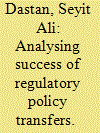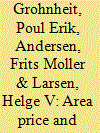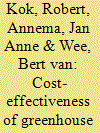|
|
|
Sort Order |
|
|
|
Items / Page
|
|
|
|
|
|
|
| Srl | Item |
| 1 |
ID:
110696


|
|
|
|
|
| Publication |
2011.
|
| Summary/Abstract |
The adoption and sustained use of improved cookstoves are critical performance parameters of the cooking system that must be monitored just like the rest of the stove technical requirements to ensure the sustainability of their benefits. No stove program can achieve its goals unless people initially accept the stoves and continue using them on a long-term basis. When a new stove is brought into a household, commonly a stacking of stoves and fuels takes place with each device being used for the cooking practices where it fits best. Therefore, to better understand the adoption process and assess the impacts of introducing a new stove it is necessary to examine the relative advantages of each device in terms of each of the main cooking practices and available fuels. An emerging generation of sensor-based tools is making possible continuous and objective monitoring of the stove adoption process (from acceptance to sustained use or disadoption), and has enabled its scalability. Such monitoring is also needed for transparent verification in carbon projects and for improved dissemination by strategically targeting the users with the highest adoption potential and the substitution of cooking practices with the highest indoor air pollution or greenhouse gas contributions.
|
|
|
|
|
|
|
|
|
|
|
|
|
|
|
|
| 2 |
ID:
110751


|
|
|
|
|
| Publication |
2011.
|
| Summary/Abstract |
Economic regulation of public utilities has become a worldwide phenomenon with the preceding privatisation stream. It is questionable to transfer regulatory models hastily without customising the policy options or introducing necessary institutional reforms enabling the achievement of expected results of regulatory reform. Institutional configuration of a country affects credibility of regulatory commitments, quality of regulatory design, and way of policy transfer. Turkey's energy market regulation experience confirms the decisive role of institutions in shaping the regulatory framework.
|
|
|
|
|
|
|
|
|
|
|
|
|
|
|
|
| 3 |
ID:
110732


|
|
|
|
|
| Publication |
2011.
|
| Summary/Abstract |
Thermodynamic losses usually take place in machineries used for agricultural activities. Therefore, it is important to identify and quantify the losses in order to devise strategies or policies to reduce them. An exergy analysis is a tool that can identify the losses occurred in any sector. In this study, an analysis has been carried out to estimate energy and exergy consumption of the agricultural sector in Malaysia. Energy and exergy efficiencies have been determined for the devices used in the agricultural sector of Malaysia, where petrol, diesel and fuel oil are used to run the machineries. Energy and exergy flow diagrams for the overall efficiencies of Malaysian agricultural sector are presented as well. The average overall energy and exergy efficiencies of this sector were found to be 22% and 20.728%, respectively, within the period from 1991 to 2009. These figures were found to be lower than those of Norway but higher than Turkey.
|
|
|
|
|
|
|
|
|
|
|
|
|
|
|
|
| 4 |
ID:
110693


|
|
|
|
|
| Publication |
2011.
|
| Summary/Abstract |
Indoor air pollution from burning solid fuels for cooking is a major environmental health problem in developing countries, predominantly affecting children and women. Traditional household energy practices also contribute to substantial time loss and drudgery among households. While effective interventions exist, levels of investment to date have been very low, in part due to lack of evidence on economic viability. Between 2004 and 2007, different combinations of interventions - improved stoves, smoke hoods and a switch to liquefied petroleum gas - were implemented in poor communities in Nepal, Sudan and Kenya. The impacts were extensively evaluated and provided the basis for a household-level cost-benefit analysis, which essentially followed the methodology proposed by the World Health Organization. The results suggest that interventions are justified on economic grounds with estimated internal rates of return of 19%, 429% and 62% in Nepal, Kenya and Sudan, respectively. Time savings constituted by far the most important benefit followed by fuel cost savings; direct health improvements were a small component of the overall benefit. This paper describes the methodology applied, discusses the findings and highlights the methodological challenges that arise when a global approach is applied to a local programme.
|
|
|
|
|
|
|
|
|
|
|
|
|
|
|
|
| 5 |
ID:
110744


|
|
|
|
|
| Publication |
2011.
|
| Summary/Abstract |
Denmark, east and west of the Great Belt are bidding areas with separate hourly area prices for the Nord Pool power exchange, covering four Nordic countries and parts of Germany. The share of wind power has now increased to 25% on an annual basis in western Denmark. This has a significant impact not only on the electricity wholesale prices, but also on the development of the market. Hourly market data are available from the website of Danish TSO from 1999. In this paper these data are analysed for the period 2004-2010. Electricity generators and customers may respond to hourly price variations, which can improve market efficiency, and a welfare gain is obtained. An important limitation for demand response is events of several consecutive hours with extreme values. The analysis in this paper is a summary and update of some of the issues covered by the EU RESPOND project. It shows that extreme events were few, and the current infrastructure and market organisation have been able to handle the amount of wind power installed so far. This recommends that geographical bidding area for the wholesale electricity market reflects external transmission constraints caused by wind power.
|
|
|
|
|
|
|
|
|
|
|
|
|
|
|
|
| 6 |
ID:
110722


|
|
|
|
|
| Publication |
2011.
|
| Summary/Abstract |
The objective of this paper is to contribute to the topic of energy supply security by proposing a Monte Carlo-based and a survey based model to analyze the costs of power interruptions. Outage cost estimations are particularly important when deciding on investments to improve supply security (e.g. additional transmission lines) in order to compare costs to benefits. But also other policy decisions on measures that have direct or indirect consequences for the supply security (e.g. a phasing out of nuclear energy) need to be based on results from outage cost estimations. The main focus of this paper lies with residential consumers, but the model is applied to commercial, industrial and governmental consumers as well. There are limited studies that have approached the problem of evaluating outage cost. When comparing the results of these studies, they often display a high degree of diversification. As consumers have different needs and dependencies towards the supply of electricity because of varying circumstances and preferences, a great diversity in outage cost is a logical consequence. To take the high degree of uncertainties into account, a Monte Carlo simulation was conducted in this study for the case of private households in Germany.
|
|
|
|
|
|
|
|
|
|
|
|
|
|
|
|
| 7 |
ID:
110750


|
|
|
|
|
| Publication |
2011.
|
| Summary/Abstract |
Due to Taiwan's lack of natural resources, dependence on imported energy, and pursuit of sustainable development, renewable energies are extremely important for Taiwan's future energy supply. Since Taiwan's feed-in tariff (FIT) is still in its initial stage, one must examine whether the current system is compatible with a well-designed FIT scheme. This study examines the main features of Taiwan's FIT system and assesses design options using several criteria. Additionally, one of the most important elements of a FIT scheme, namely, a tariff system, is discussed. Taiwan's FIT scheme has the design options required by well-functioning FITs, and the guaranteed-return tariff system coincides with the spirit underlying leading global FITs; however, many issues, such as setting goals by stages, refinement of the tariff calculation methodology, and elimination of other non-economic barriers, must be addressed to achieve future developmental goals and green industry growth.
|
|
|
|
|
|
|
|
|
|
|
|
|
|
|
|
| 8 |
ID:
110703


|
|
|
|
|
| Publication |
2011.
|
| Summary/Abstract |
China's rapid economic growth has led to a huge increase in oil imports. This has raised great concern regarding its energy security because China depends on a single chokepoint, the Strait of Malacca, with nearly three-quarters of its oil imports flowing through the Strait. Given its strategic importance to China and China's little sway on the waterway, this viewpoint focuses mainly on China's concerns about and efforts at both demand and supply sides towards energy security, in particular regarding the Malacca dilemma, and puts potential Arctic oil and gas into that context.
|
|
|
|
|
|
|
|
|
|
|
|
|
|
|
|
| 9 |
ID:
110756


|
|
|
|
|
| Publication |
2011.
|
| Summary/Abstract |
China has emerged as a leader in coal liquefaction. While the country's abundant coal resources and acute concerns about oil security help explain China's interest in liquefaction, the driving forces for this industry are complicated and policy has been inconsistent. Since 2006 Beijing has tried to slow down the development of liquefaction; even as China has become more dependent on imported oil, the central government has been wary about the large impact of liquefaction technologies on scarce resources such as water. However, local government officials in coal rich areas have strong incentives to pour investment into the technology, which helps explain the uneven development and policy. The future of coal liquefaction will depend on how these forces unfold along with major Beijing-led reforms in the Chinese coal industry, which is closing smaller mines and favoring the emergence of larger coal producing firms. Those reforms will have mixed effects on liquefaction. They temporarily contribute to higher prices for coal while over the longer term creating coal companies that have much greater financial and technical skills needed to deploy technologies such as coal liquefaction at a scale needed if this energy pathway is to be competitive with conventional sources of liquid fuel.
|
|
|
|
|
|
|
|
|
|
|
|
|
|
|
|
| 10 |
ID:
110704


|
|
|
|
|
| Publication |
2011.
|
| Summary/Abstract |
This paper introduces two typical multicyclic models: the Hubbert model and the Generalized Weng model. The model-solving process of the two is expounded, and it provides the basis for an empirical analysis of the world's conventional oil production. The results for both show that the world's conventional oil (crude+NGLs) production will reach its peak in 2011 with a production of 30 billion barrels (Gb). In addition, the forecasting effects of these two models, given the same URR are compared, and the intrinsic characteristics of these two models are analyzed. This demonstrates that for specific criteria the multicyclic Generalized Weng model is an improvement on the multicyclic Hubbert model. Finally, based upon the resultant forecast for the world's conventional oil, some suggestions are proposed for China's policy makers.
|
|
|
|
|
|
|
|
|
|
|
|
|
|
|
|
| 11 |
ID:
110705


|
|
|
|
|
| Publication |
2011.
|
| Summary/Abstract |
Study of low-carbon and pollution renewable alternatives for China revealed that concentrating solar thermal (CST) electric power generation was underemphasized in China's renewable energy plan. The analysis shows the competitive viability of CST: (1) China has the key prerequisites to make CST power generation economical including high-quality insolation and appropriate land, (2) CST's proven history, scale, and dispatchability makes it a good utility-scale power option, especially in the economically underdeveloped Western regions, (3) while CST power is currently more expensive than coal-fired electricity on a nominal basis, when costs of externalities are accounted for, CST, at 11.4 US cents/kWh, can become 57% cheaper than scrubbed coal and 29% cheaper than nuclear power, (4) CST power continues dropping in cost due to economies of scale and technological improvements and can potentially realize a levelized electricity cost of around 4 cents/kWh within ten years, (5) it would significantly rise in competitiveness if and when China completes the extensive smart grid for connecting its solar-abundant western regions with the high-demand eastern regions, (6) CST has the potential to positively impact Western China's economy, but proper policy and deal structure must be in place to ensure that the local community shares the benefit.
|
|
|
|
|
|
|
|
|
|
|
|
|
|
|
|
| 12 |
ID:
110729


|
|
|
|
|
| Publication |
2011.
|
| Summary/Abstract |
The areas of energy, water and food policy have numerous interwoven concerns ranging from ensuring access to services, to environmental impacts to price volatility. These issues manifest in very different ways in each of the three "spheres", but often the impacts are closely related. Identifying these interrelationships a priori is of great importance to help target synergies and avoid potential tensions. Systems thinking is required to address such a wide swath of possible topics. This paper briefly describes some of the linkages at a high-level of aggregation - primarily from a developing country perspective - and via case studies, to arrive at some promising directions for addressing the nexus. To that end, we also present the attributes of a modelling framework that specifically addresses the nexus, and can thus serve to inform more effective national policies and regulations. While environmental issues are normally the 'cohesive principle' from which the three areas are considered jointly, the enormous inequalities arising from a lack of access suggest that economic and security-related issues may be stronger motivators of change. Finally, consideration of the complex interactions will require new institutional capacity both in industrialised and developing countries.
|
|
|
|
|
|
|
|
|
|
|
|
|
|
|
|
| 13 |
ID:
110718


|
|
|
|
|
| Publication |
2011.
|
| Summary/Abstract |
A review is given of methodological practices for ex ante cost-effectiveness analysis (CEA) of transport greenhouse gas (GHG) mitigation measures, e.g. fuel economy and CO2 standards for road vehicles in the US and EU. Besides the fundamental differences between different types of policies and abatement options which inherently result in different CEA outcomes, differences in methodological choices and assumptions are another important source of variation in CEA outcomes. Fourteen methodological issues clustered into six groups are identified on which thirty-three selected studies are systematically reviewed. The potential variation between lower and upper cost-effectiveness estimates for GHG mitigation measures in transport, resulting from different methodological choices and assumptions, lies in the order of $400 per tonne CO2-eq. The practise of using CEA for policy-making could improve considerably by clearly indicating the specific purpose of the CEA and its strengths and limitations for policy decisions. Another improvement is related to the dominant approach in transport GHG mitigation studies: the bottom-up financial technical approach which assesses isolated effects, implying considerable limitations for policy-making. A shift to welfare-economic approaches using a hybrid model has the potential to establish an improved assessment of transport GHG mitigation measures based on realistic market responses and behavioural change.
|
|
|
|
|
|
|
|
|
|
|
|
|
|
|
|
| 14 |
ID:
110719


|
|
|
|
|
| Publication |
2011.
|
| Summary/Abstract |
Transport is the second emitter of CO2 in the European Union, after the energy production sector, with constantly increased trend. European Union proposed the regulation 443/2009 to control the CO2 emissions from new passenger cars. According to that regulation, the average, for each car manufacturer, CO2 emissions of the new passenger cars registered in 2020 in European Union should not exceed the value of 95 g CO2/km on the New European Driving Cycle. In the present work the regulation 443/2009 is analyzed and a critique is addressed to four points. The first point concerns the average upper limit of CO2 emissions of each car manufacturer. The second point concerns the possible derogation for the low volume manufacturers and the third to the penalties for the extra CO2 emissions. The fourth point concerns the value of the proposed average upper limit of CO2 emissions and the possibility to be changed in the future. A change to the above points is proposed. The maximum decrease of CO2 emissions and the principle of equality of citizens are the two principles of our propositions for the CO2 regulations.
|
|
|
|
|
|
|
|
|
|
|
|
|
|
|
|
| 15 |
ID:
110755


|
|
|
|
|
| Publication |
2011.
|
| Summary/Abstract |
Within the next years, consumer households will be increasingly equipped with smart metering and intelligent appliances. These technologies are the basis for households to better monitor electricity consumption and to actively control loads in private homes. Demand side management (DSM) can be adopted to private households. We present a simulation model that generates household load profiles under flat tariffs and simulates changes in these profiles when households are equipped with smart appliances and face time-based electricity prices.
We investigate the impact of smart appliances and variable prices on electricity bills of a household. We show that for households the savings from equipping them with smart appliances are moderate compared to the required investment. This finding is quite robust with respect to variation of tariff price spreads and to different types of appliance utilization patterns.
Finally, our results indicate that electric utilities may face new demand peaks when day-ahead hourly prices are applied. However, a considerable amount of residential load is available for shifting, which is interesting for the utilities to balance demand and supply.
|
|
|
|
|
|
|
|
|
|
|
|
|
|
|
|
| 16 |
ID:
110711


|
|
|
|
|
| Publication |
2011.
|
| Summary/Abstract |
A key selling point for the restructuring of electricity markets was the promise of lower prices. There is not much consensus in earlier studies on the effects of electricity deregulation in the U.S., particularly for residential customers. Part of the reason for not finding a consistent link with deregulation and lower prices was that the removal of transitional price caps led to higher prices. In addition, the timing of the removal of price caps coincided with rising fuel prices, which were passed on to consumers in a competitive market. Using a dynamic panel model, we analyze the effect of participation rates, fuel costs, market size, a rate cap and switch to competition for 16 states and the District of Columbia. We find that an increase in participation rates, price controls, a larger market, and high shares of hydro in electricity generation lower retail prices, while increases in natural gas and coal prices increase rates. We also find that retail competition makes the market more efficient by lowering the markup of retail prices over wholesale costs. The effects of a competitive retail electricity market are mixed across states, but generally appear to lower prices in states with high participation rates.
|
|
|
|
|
|
|
|
|
|
|
|
|
|
|
|
| 17 |
ID:
110748


|
|
|
|
|
| Publication |
2011.
|
| Summary/Abstract |
Biomass is a renewable energy source of increasing importance, especially since the energy policies of countries today are largely focused on renewable energy. It is a renewable energy source with significant potential to contribute to the energy needs of modern society, both for developing and developed countries around the world. One very important source of biomass is wood and fuelwood in particular. This article aims at providing an empirical analysis of household fuelwood consumption and the determinants of the choice to use the specific energy for heating and cooking in a district of Northern Greece. In the current empirical analysis several household fuelwood consumption models are employed, such as GLM, Tobit and Heckman regression-based techniques. The results show that household sociological and economical characteristics as well as more general environmental issues are suitable to explain differences towards fuelwood consumption for space heating and cooking. We additionally evaluate the household fuelwood consumption for heating through the statistical analyses conducted.
|
|
|
|
|
|
|
|
|
|
|
|
|
|
|
|
| 18 |
ID:
110757


|
|
|
|
|
| Publication |
2011.
|
| Summary/Abstract |
This study analyzes the effects of oil price fluctuations on regional macroeconomic variables with a structural VAR model. We classified fifteen metropolitan cities and provinces of Korea into four major regions (Capital, Central, Honam, and Gyeongsang) and examined the effects of oil price fluctuations on the economy of these regions. The results in the short- and long-term lag structures show a negative response to industrial production and price. The Capital region is less affected by oil price fluctuations than the other three provincial regions. We concluded that the government should focus on creating an industrial environment to accumulate production factors and technologies in oil price-sensitive regions.
|
|
|
|
|
|
|
|
|
|
|
|
|
|
|
|
| 19 |
ID:
110723


|
|
|
|
|
| Publication |
2011.
|
| Summary/Abstract |
This paper questions the assumption, commonly used in theoretical and policy research, that scarcity rents make up a large proportion of market prices for oil and coal. We show that the empirical literature, simple calculations of historical and future scarcity rent shares, and possible theoretical explanations all imply the same overall conclusions: that scarcity rents seem to have been marginal or non-existent historically; that they almost certainly do not dominate fossil resource prices today; and that there will be other factors shaping the prices in the upcoming decades. We therefore argue that using the scarcity rent as the main or only basis for policy or for explaining empirical outcomes is ill-advised.
|
|
|
|
|
|
|
|
|
|
|
|
|
|
|
|
| 20 |
ID:
110697


|
|
|
|
|
| Publication |
2011.
|
| Summary/Abstract |
Easy energy access is a trigger for human, social, and economic development. A research project was undertaken in Sri Lanka to broaden the understanding of human dimension of energy access and technologies. A questionnaire survey, covering 2269 households, gathered data on socio-economic contexts and issues influencing a transition towards clean cooking facilities. The findings reveal that the transition is impeded by four factors: the lack of motivation and the pressure for switching over to cleaner facilities, the lack of modern energy technology options, the financial risks, and the lack of financing and other support. The paper describes the delicate two-way interrelation between women earning wages and the transitions to cleaner cooking fuels and technologies. The findings suggest the need for a policy framework involving the stakeholders, financing and standardised technologies. To make a change it is proposed to introduce a national, integrated policy incorporating financing and energy governance.
|
|
|
|
|
|
|
|
|
|
|
|
|
|
|
|
|
|
|
|
|